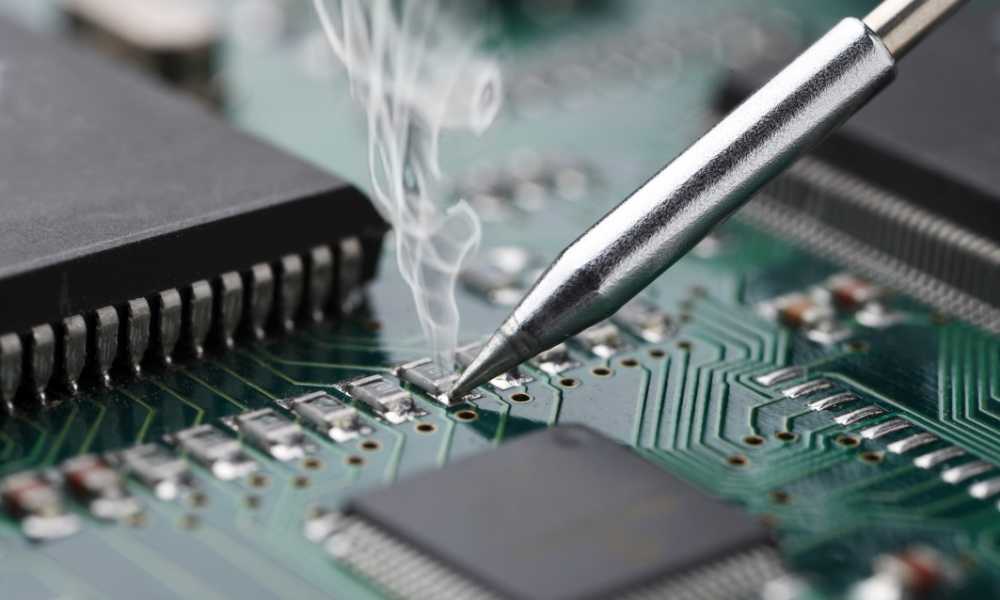Until you get your hands on a soldering iron with adjustable temperature levels, the majority of people don’t usually think about how hot their soldering iron can get.
As one of the most powerful tools that you can get your hands on, knowing the capabilities of your soldering iron can surely help you make the most out of using it. It’s not only important to know how hot does a soldering iron get, but also what temperature settings are recommended for different materials.
What Does Soldering Mean?
The general term “soldering” means you’ll be joining two materials together, most likely metals, by fusing the alloys together. Both of the metals will have a very low melting point, approximately 450°C, which makes them incredibly simple to connect. A great example would be if you were to do arts and crafts where you have to glue a piece of felt to a piece of paper, it’s nearly the same premise, just with the use of specialized tools.
In most cases, when you hear “soldering,” it will typically be concerning fusing alloys together to hold certain pieces together or create electrical connections. Plenty of welders will also use soldering irons to create gas or liquid-tight joints in pipes and other items.

What Is the Maximum Temperature of a Soldering Iron?
The first thing you’ll realize when you ask how hot does a soldering iron get is that soldering irons are going to have different maximum temperatures, especially if you’re looking at models with variable settings. At times, you may be able to find a specific soldering iron for a particular alloy, though it’s always recommended to opt for variable settings as it helps to make the tool more versatile based on the solders you’re working with.
Some models may only get as hot as 450°C, whereas other models can get as hot as 1400°C. With that being said, the maximum temperature of your soldering iron isn’t what is important, but it’s the melting point of the solders (or alloys) that you’re working with.
Choosing a Soldering Iron with the Right Temperature
As mentioned, when it comes to buying a soldering iron, the main thing you’re going to have to think about are the alloys you’ll be working with as this will have a huge impact over what model is best suited for your needs. Ideally, you’re going to want to choose a soldering iron that offers temperatures higher than the melting points of the alloys. For example, the solder will melt at approximately 190°C and so opting for an iron that is hotter than this will work perfectly.
This also has a direct relevance to knowing what to set your soldering temperature at, particularly if you have one with adjustable temperature settings. First, you’re going to need to figure out whether you have a high or low effect iron with a small or large tip.
Soldering irons that are high-effect with a large tip can operate with substantially less power and will still provide the same results. For example, working with alloys that melt at 190°C with a high-effect, large tip soldering iron only takes 250°C. On the other end of the spectrum, if you have a low effect iron with a small tip, you’ll need a higher temperature of around 400°C.
The Importance of Practice
Unless you were fortunate enough to go to a trade school in order to learn how to properly solder materials, you’ll be stuck with the basic process of trial and error. However, when compared to other power tools that you might be trying to learn on your own, as long as you take the appropriate safety precautions, learning how to solder at home is easier than you think.
The more often you’re able to get your hands on different materials, the easier it’s going to be to learn the ideal melting point of certain alloys. Over time, with more practice, you’ll be in a position to where you can easily set the perfect temperature for the ideal solder every time.
The easiest way to know what temperature is best is to pay attention to what you’re doing. If you find the solder isn’t melting as easy as you’d think, try turning the temperature up, whereas if the solder is burning, you’ll need to turn the temperature down.

How Hot Does a Soldering Iron Get? It Depends!
Even though soldering irons can get up to 1400°C or higher, it doesn’t necessarily mean you need to find an iron that can get hotter than all of the other models on the market. The most important thing to think about, aside from being safe while using the iron, is the type of metal you’ll be using for your specific project as you might find that you need a cooler temperature than you originally thought.
FINAL VERDICT
At the end of the day, the easiest way to have complete control over your soldering iron is to get a model with an adjustable dial so that you can choose the perfect temperature for any task and you can play around with different metals to get a hang of the process.


